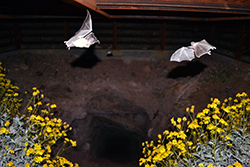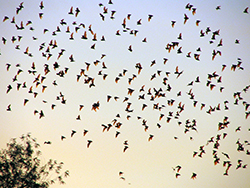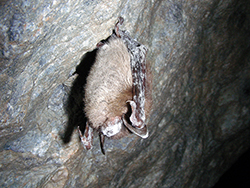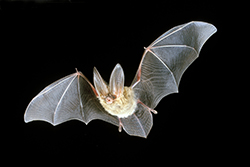
California leaf-nosed bats. CDFW photo by retired biologist Andy Moore.

Hundreds of bats in flight. ©Dave Feliz, all rights reserved.

Little brown bat with white-nose syndrome. US Fish and Wildlife Service photo.

Townsend's big-eared bat in flight. National Park Service photo.
The last seven days of October are celebrated each year as Bat Week – a time to learn about the importance of bats in our environment.
Bats are nature’s best pesticide. According to a study by the University of California, Davis, Division of Agriculture and Natural Resources, each of these small mammals eats between half and 100 percent of its own weight in insects every night. Some California species consume as many as 600 insects per hour. Imagine living with all the mosquitoes, flies, midges, moths and agricultural pests that are now consumed by bats!
In monetary terms, the natural pest control that bats provide is extremely valuable to the state’s $54 billion per year agriculture and $450 million timber industries. The bats’ appetite reduces the need for chemical pesticides, reduces crop losses and curtails the spread of crop diseases. According to the US Geological Survey, a recent economic analysis indicated that insect suppression services provided by bats to American agriculture is worth something between $4 billion and $50 billion per year.
California Department of Fish and Wildlife (CDFW) Senior Environmental Scientist Scott Osborn notes the estimate’s wide range makes it hard to know exactly how much money bats save farmers. “But even the low estimate, $4 billion, is an impressive amount,” he said. “Bats are an important part of integrated pest management systems.”
As the wildlife trustee agency in California, CDFW is engaged in several activities to help us understand the conservation status of bats in the state, as well as to address threats to bat populations. At statewide, regional and local scales, our scientists have been deploying acoustic bat detectors to determine the distribution of California’s 25 bat species. When CDFW’s bat acoustic data are combined with data collected by partners at other state and federal agencies, academic researchers and non-governmental organizations, we should have more accurate knowledge of where various bat species occur, as well as their seasonal movements.
White Nose Syndrome (WNS) is now a real threat to California’s bats. WNS is a fungal disease that is estimated to have killed more than 6 million bats in eastern North America. With the discovery of WNS for the first time on the west coast (in Washington state) last year, California is bracing for potentially devastating impacts to our bat populations. CDFW is working with the US Fish and Wildlife Service and other partners to conduct surveillance for the fungus that causes the disease, as well as develop plans to manage the disease when it arrives in California. So far, all of the samples collected from bats and their roosts in California have been free of the fungus, but increased vigilance is necessary to help ensure the disease is detected immediately when it arrives. Special measures to reduce the impact of WNS on hibernating bats may include closing caves and other roosts to visitors, because people can unwittingly spread the fungus on their clothing, shoes and gear. Ultimately, it is hoped that ongoing research into the disease will provide tools to either eliminate or control the fungus, both in the environment and in infected bats.
To learn more about the exciting world of bats and how you can “Go to Bat for Bats!” check out the  Bat Week 2017 website.
Bat Week 2017 website.
Top photo: A California bat in a crevice. ©Dave Feliz, all rights reserved.